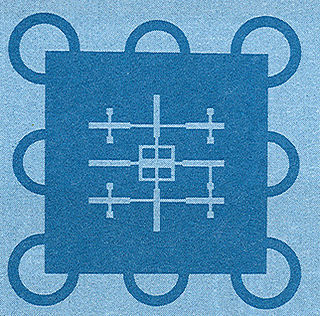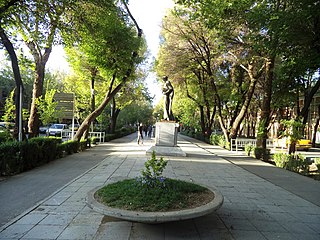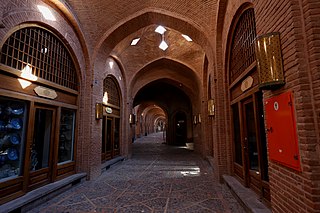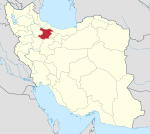
Qazvin ProvinceIPA:[ɢæzˈviːn] is one of the 31 provinces of Iran. It is in the northwest of the country, with the city of Qazvin as its capital. The province was carved out of Tehran province in 1993. At the time of the National Census of 2006, the population of the province was 1,127,734 in 294,305 households. The following census in 2011 counted 1,201,565 inhabitants living in 352,472 households, of whom 68.05% lived in cities and 31.95% in villages. By the time of the most recent census in 2016, the population had risen to 1,273,761 people in 397,165 households.

Qazvin is a city in the Central District of Qazvin County, Qazvin province, Iran, serving as capital of the province, the county, and the district. It is the largest city in Qazvin province.

Meimoon Ghal'eh, also known as Mehman Ghal'eh and Mobarak Ghal'eh, is one of several castle ruins scattered throughout the Qazvin area, in Iran.

The al-Nabi Mosque is a famous mosque in Qazvīn. The mosque has an area of about 14,000 m2, and bears inscriptions indicating that Fath Ali Shah of the Qajar dynasty was the founder of the mosque. Other sources however indicate that the mosque has been in existence since the Safavid period. It is now believed that the architect of the structure was Ustad Mirza Shirazi with the date of construction being 1787. This glorious mosque also known as Masjed Nabi, Masjed Soltani or Masjed Shah.

Chahar Bagh Boulevard is a historical avenue in Isfahan constructed in the Safavid era of Iran. This histories street is very similar to the Champs-Élysées in Paris, which some visitors called the Champs-Élysées of Isfahan.

The Sa'd al-Saltaneh Caravanserai is a large Caravanserai located in the city of Qazvin in Qazvin Province of Iran.
Miadzhik is a village in the Absheron Rayon of Azerbaijan.
Kürdçü is a village in the Hajigabul Rayon of Azerbaijan. The village forms part of the municipality of Atbulaq.

Proma Hypermarket as an Iranian supermarket chain is launched in three cities of Iran including Mashhad, Tehran, and Qazvin. Proma Hypermarket in Mashhad is a 420,000 m² complex comprising a shopping mall located near Janbaz Square, Mashhad, Iran.

The Shah Nematollah Vali Shrine is a historical complex, located in Mahan, Iran, which contains the mausoleum of Shah Nematollah Vali, the renowned Iranian mystic and poet. Shah Nematollah Vali died in 1431 aged over 100. In 1436 a shrine was erected in his honor and became a pilgrimage site; with the attention of successive rulers contributing various additions over the centuries.
Danesfahan is a city in, and the capital of, Ramand District of Buin Zahra County, Qazvin province, Iran. It was originally the capital of Ramand-e Jonubi Rural District, however the capital has been transferred to the village of Khuznin.
Ain is a village in Moallem Kalayeh Rural District, Rudbar-e Alamut District, Qazvin County, Qazvin Province, Iran. At the 2006 census, the village population comprised 13 residents, in 4 households.
Hoseynabad-e Eqbal is a village in Eqbal-e Gharbi Rural District, in the Central District of Qazvin County, Qazvin Province, Iran. At the 2006 census, its population was 85, in 25 families.
Kushk is a village in Moallem Kalayeh Rural District, Rudbar-e Alamut District, Qazvin County, Qazvin Province, Iran. At the 2006 census, the village population comprised 710 residents, in 160 households.
Juyank is a village in Rudbar-e Mohammad-e Zamani Rural District, Alamut-e Gharbi District, Qazvin County, Qazvin Province, Iran. At the 2006 census, its population was 351, in 90 families.
Tanureh is a village in Rudbar-e Mohammad-e Zamani Rural District, Alamut-e Gharbi District, Qazvin County, Qazvin Province, Iran. At the 2006 census, its population was 130, in 49 families.

Alamut or Rudbar is a region in Iran including western and eastern parts on the western edge of the Alborz (Elburz) range, between the dry and barren plain of Qazvin in the south and the densely forested slopes of the Mazandaran province in the north. Starting from Qazvin toward Alamut, passing through the first range of hills, curvatures, forms, are significant themes in nature's composition of this area. The famous Ismaili castle of Alamut and numerous others are in this area, which served as the heartland of the state founded by Hassan-i Sabbah.

Chehel Sotun, originally named Kolah Farangi Mansion is a Safavid era royal pavilion located in Qazvin, Iran.

Haj Kazem Ab Anbar is an Ab Anbar in Qazvin, Iran. Built in 1840–1841 by Haj Kazem Kuzegar, it is one of the numerous Ab Anbars of the city of Qazvin that were used to store water. There are two windcatchers of eight meters in height attached to it which were used to cool down the water in the reservoir.

Sardar-e Kuchak Ab Anbar is an Ab Anbar in Qazvin, Iran. Built in 1814, it is one of the two Ab Anbars that were built by two brothers named Mohammad Hassan Khan and Mohammad Hossein Khan, the other being Sardar-e Bozorg Ab Anbar.













